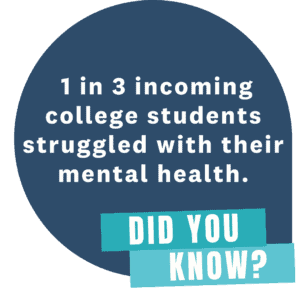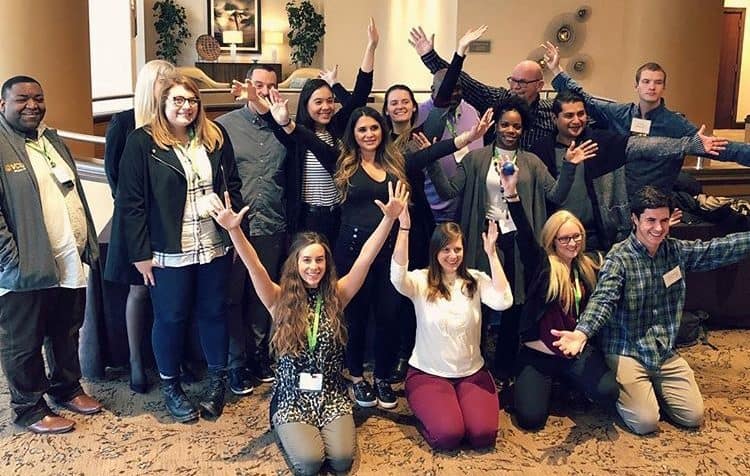As the country simultaneously navigates an addiction crisis and the COVID-19 pandemic, improving the mental health and wellness among young adults has been a priority of increasing importance. A 2018 report found that approximately 1 in 3 incoming college students struggled with their mental health: the COVID-19 pandemic has exacerbated this trend and a survey in 2020 found that 71% of students indicated they faced increased levels of stress, anxiety, and depressive thoughts. As colleges work to meet the demand for mental health support on campus, administrators would be remiss to overlook addiction and recovery as aspects of holistic wellness: Researchers have found that about half of individuals who experience substance use disorder (SUD) will also experience a co-occurring mental health disorder and vice versa.

Barriers for Community Colleges
Why don’t community colleges have larger representation in the collegiate recovery movement? The under-representation of community colleges within the collegiate recovery movement is particularly troubling considering that community colleges enroll nearly half of all college students, with about 9 million students attending community colleges annually. Because community colleges offer affordable tuition, accessible admissions, and convenience, they have been particularly popular with nontraditional students, including those that are older, working, or attending part-time. The flexibility offered by community colleges makes them ideally suited for people in recovery, especially students in the early stages of recovery who are often advised to ease back into college life gradually and pursue light course loads.
Heather Asbury, a student in recovery who works full time and attends Community College of Baltimore County, noted that these benefits directly impacted her decision to attend: “What I love about my college is the ease of applying, the knowledge of the advisors, and the honest suggestions from the head of the program I attend…all of my classes have been online. The ease of online learning systems, the effective communications between professors and students, and the assignments to test our knowledge are all effective.”
Most new programs are fueled by students and professionals moving from universities with collegiate recovery initiatives to those without them. Unfortunately for community colleges, students typically transfer out of these schools and on to four-year degree-granting institutions. If growth has historically been generated by transfer students, it is unsurprising that growth in the community college sector wouldn’t match that of four-year institutions.
Student movement across institutions is not only a barrier to starting recovery programs at community colleges, it’s a barrier to maintaining them as well. A 2018 report on the state of collegiate recovery in community college settings found that student leadership transition is a key concern: the majority of community college recovery programs exist as student clubs or drop-in centers, and student leaders are critical in attracting and engaging their peers in these programs. But successful community college students may only spend a handful of semesters enrolled at the campus before graduating or transferring, thus every new semester is a new beginning, requiring re-recruitment and re-engagement for the recovery community to thrive. The public awareness, marketing, and recruitment work necessary to fill a collegiate recovery community’s ranks require time, effort, and resources. Often this work is done by the student members and leaders within the collegiate recovery community, and these communities lose their best champions as their students graduate and transition out.
Most new programs are fueled by students and professionals moving from universities with collegiate recovery initiatives to those without them.Dr. Kimberly Boulden, Senior Director of SAFE Campuses
SAFE Campuses Can Help!
The SAFE Campuses team has seen first-hand that connection between peers in recovery can be transformative. After completing SAFE’s Collegiate Recovery Leadership Academy (CRLA) alongside about 30 other students in recovery, Katy Munstis (Cape Cod Community College) noted, “Being with this group strengthened and broadened my recovery… I know that I have made connections and friendships for life.” Jim Duffy (Montgomery County Community College) echoed this sentiment, “I believed in the goal of introducing more campus recovery programs from the start. It’s a long ignored and forgotten need that has great potential for helping so many. [I’ve had the] wonderful opportunity to lay the groundwork for personal and professional growth in many areas.”
The SAFE Campuses team is working to directly target our programming to more individuals from community colleges. Through dedicated funding, flexible programming, targeted recruitment, and strategic coalition building, we hope to empower more community and technical colleges to increase the recovery capital on their campuses.
For students and professionals at community colleges looking to create or expand resources, the SAFE Campuses team offers technical assistance, including resources on how to formulate proposals, leverage community and peer networks, advocate for administrator support, and work towards policy change. With everything we do, the team works to personalize and tailor solutions to fit the needs of each campus. SAFE Campuses also works with students and schools interested in exploring harm reduction efforts on campus and can connect campuses with training opportunities and resources.
Heather’s advice to her fellow community college students in recovery? “If you have the capability, help your college develop a collegiate recovery program (CRP), or if they already have one, JOIN! We are power in numbers! Also, do not let your recovery status or the inferiority complex hold you back from continuing or enrolling. People who have lived experience of addiction and/or mental health are some of the smartest people on the planet. You will surprise yourself. DO IT!”
We couldn’t agree more. We know navigating systems of higher education and creating sustainable programs can be tricky, learn how the SAFE Campuses team can help at www.safeproject.us/campuses/technical-assistance.


